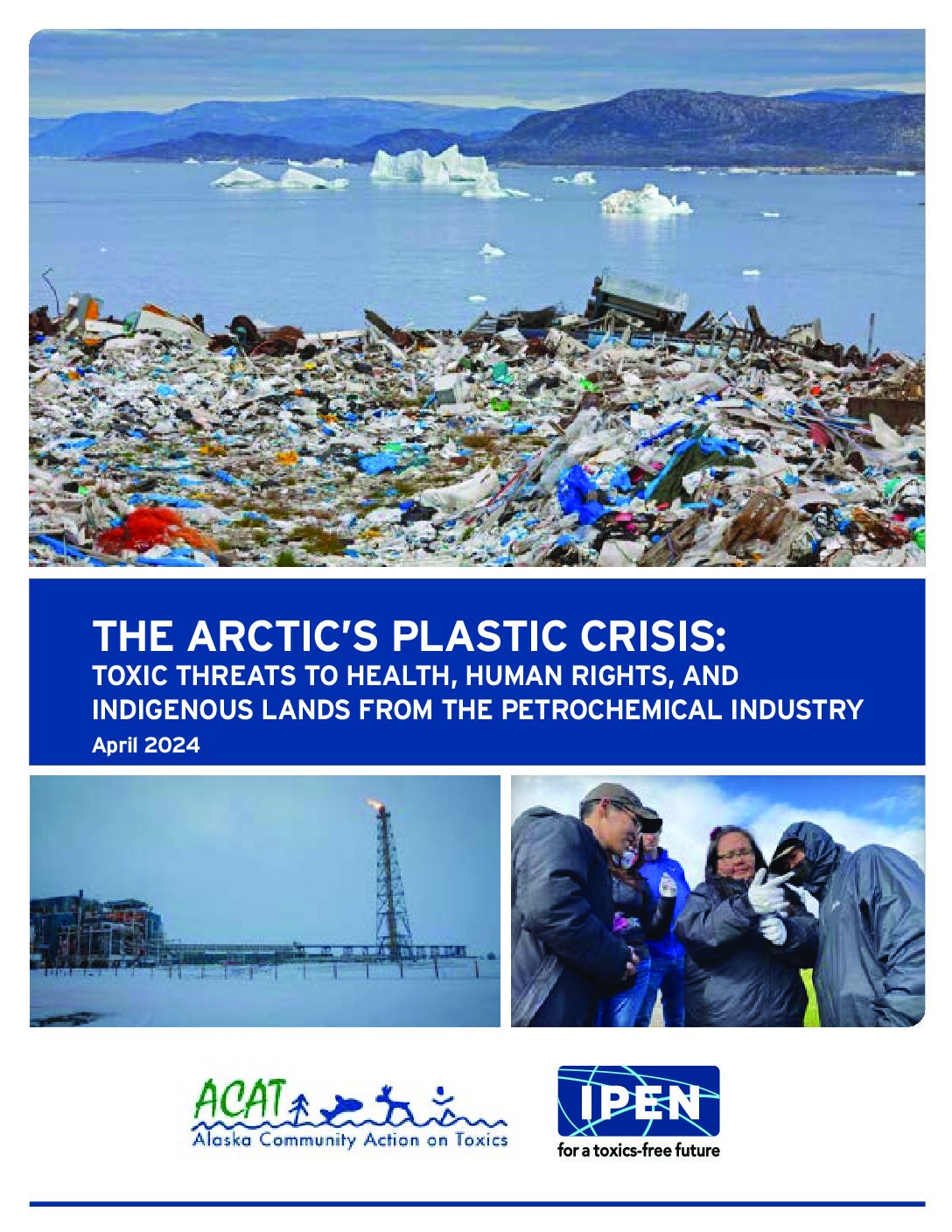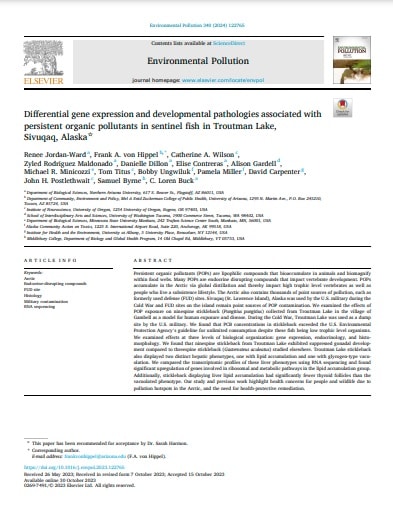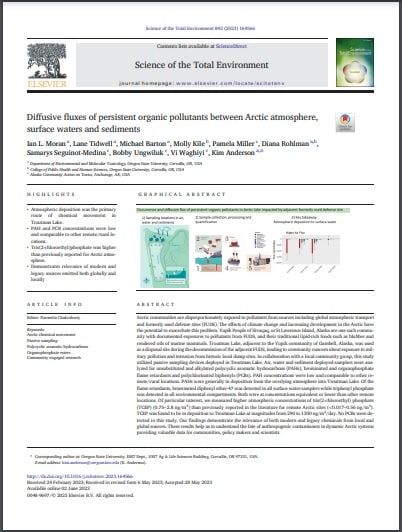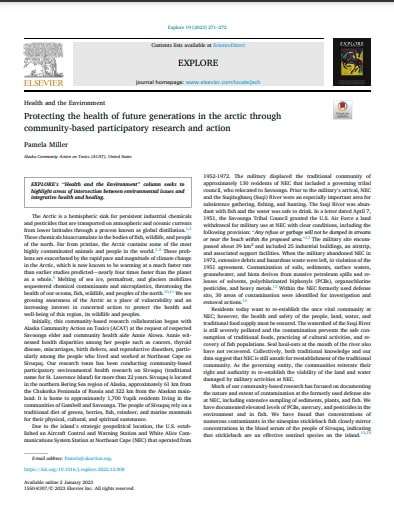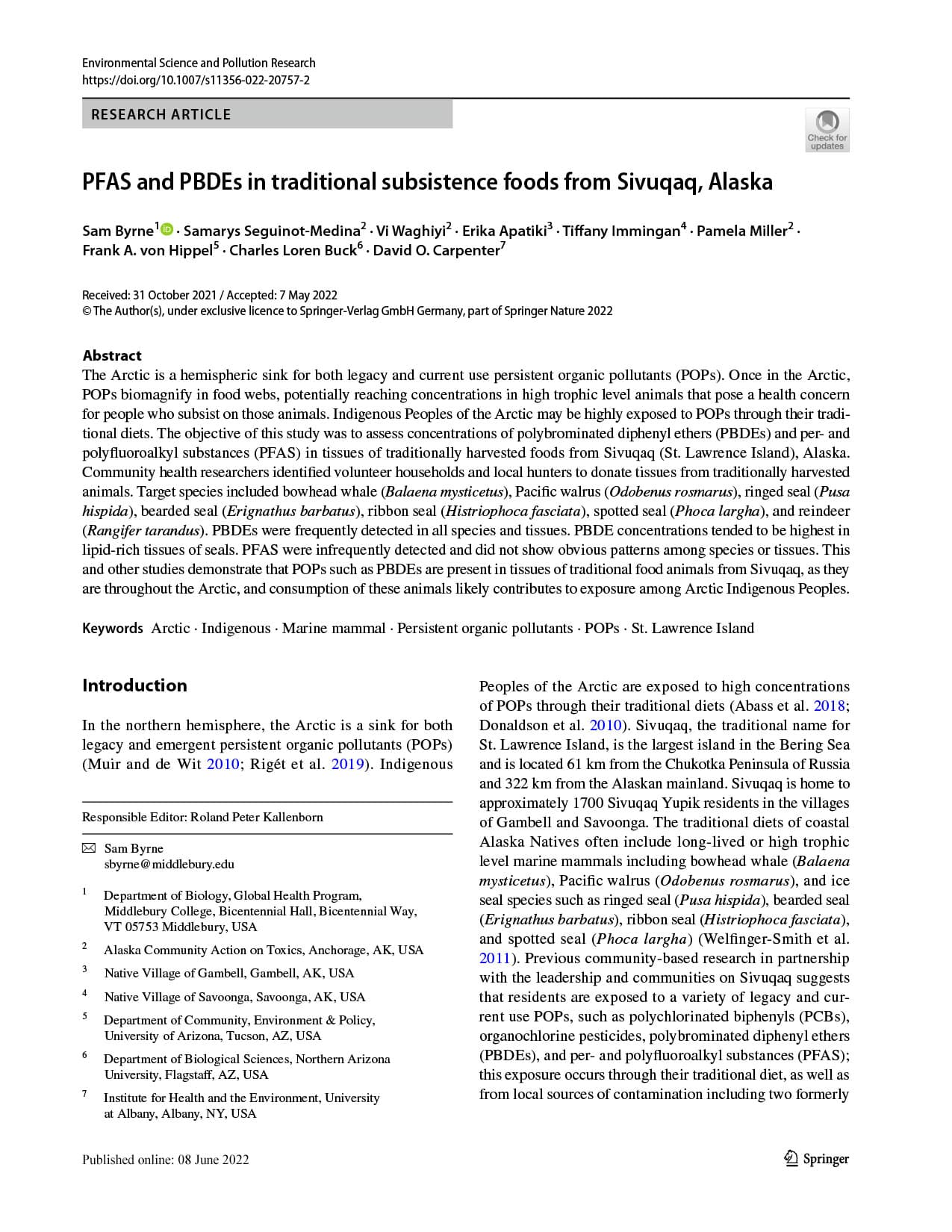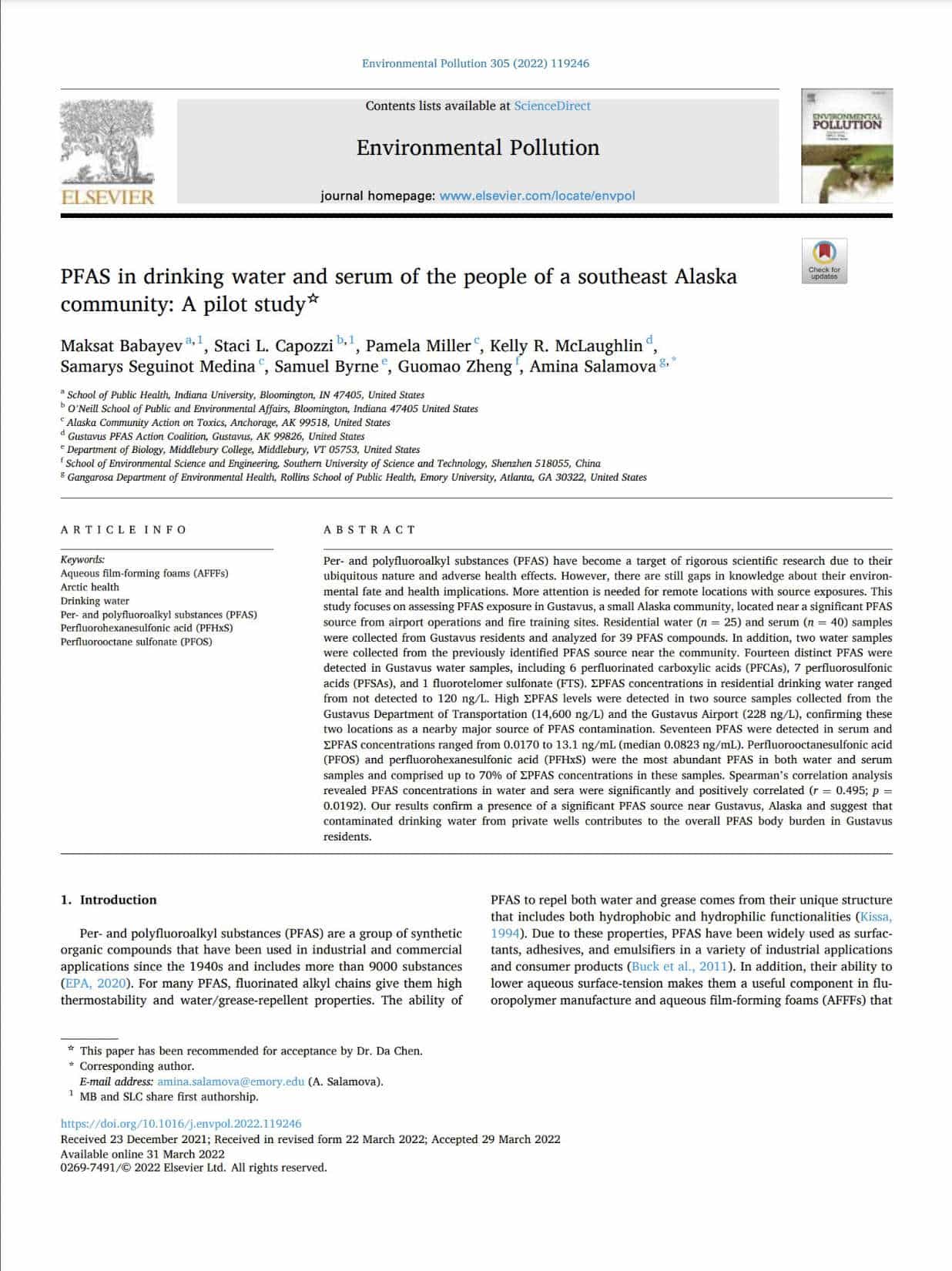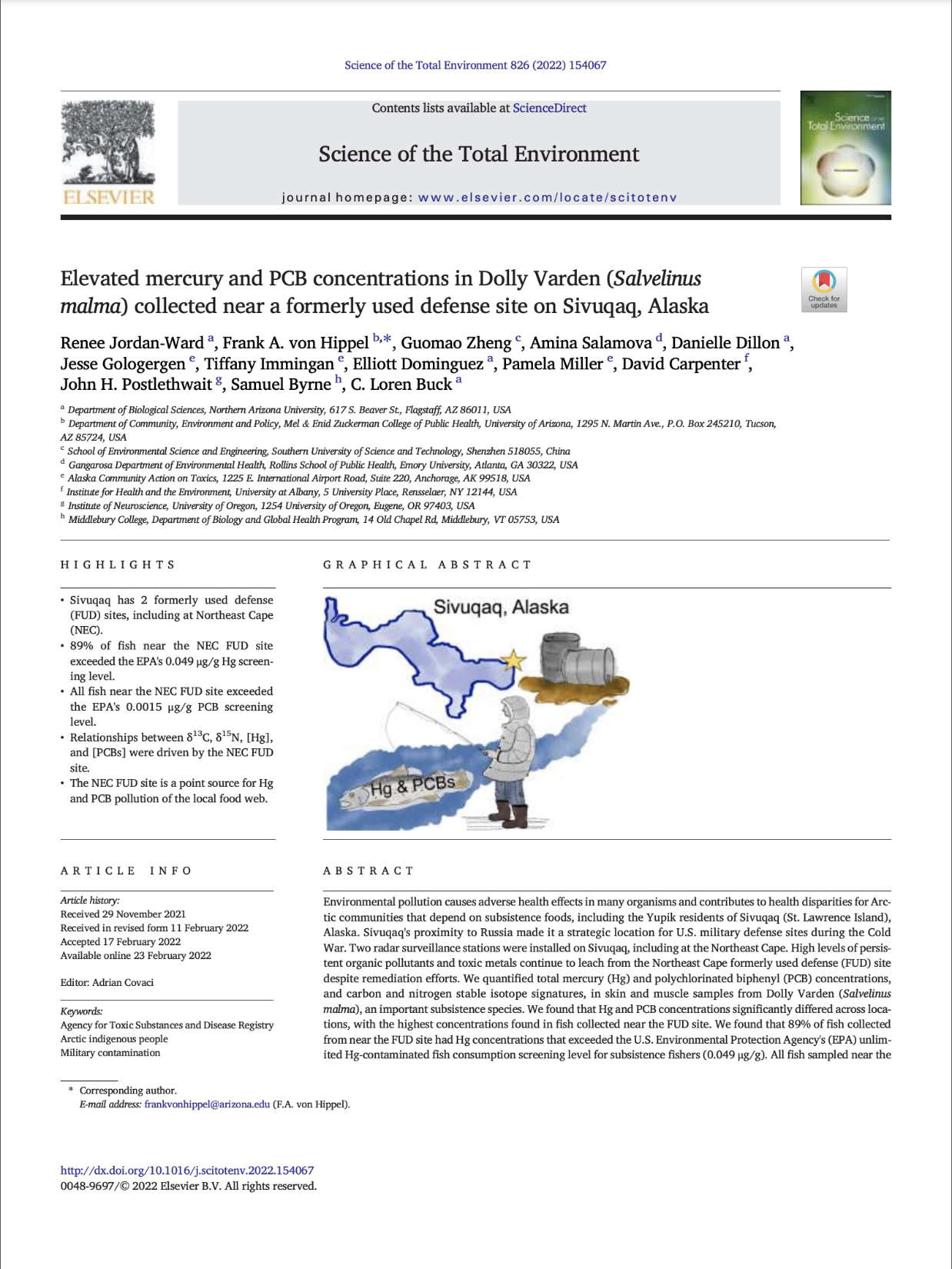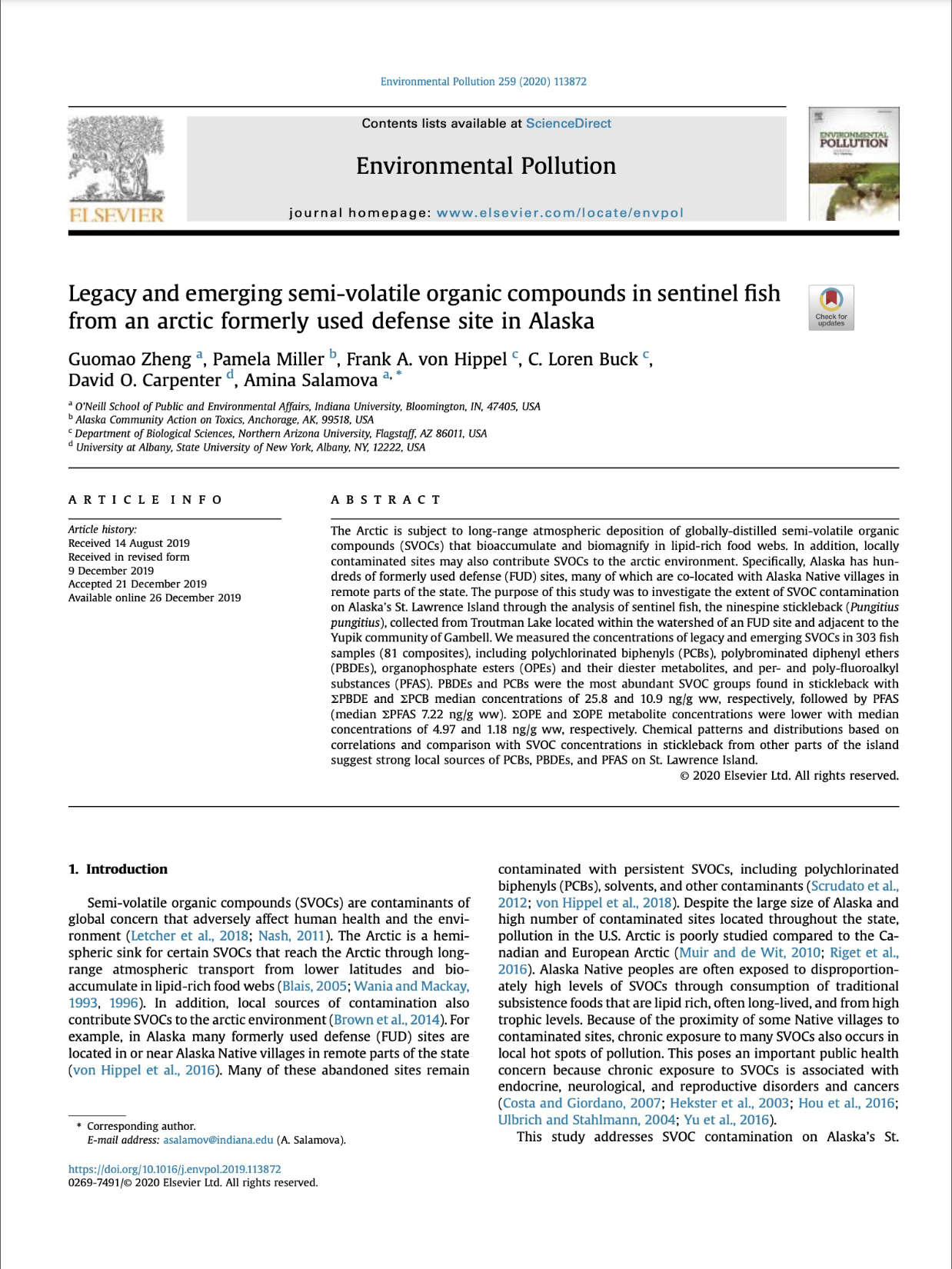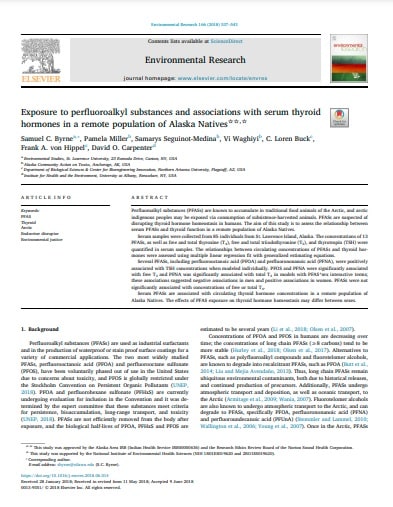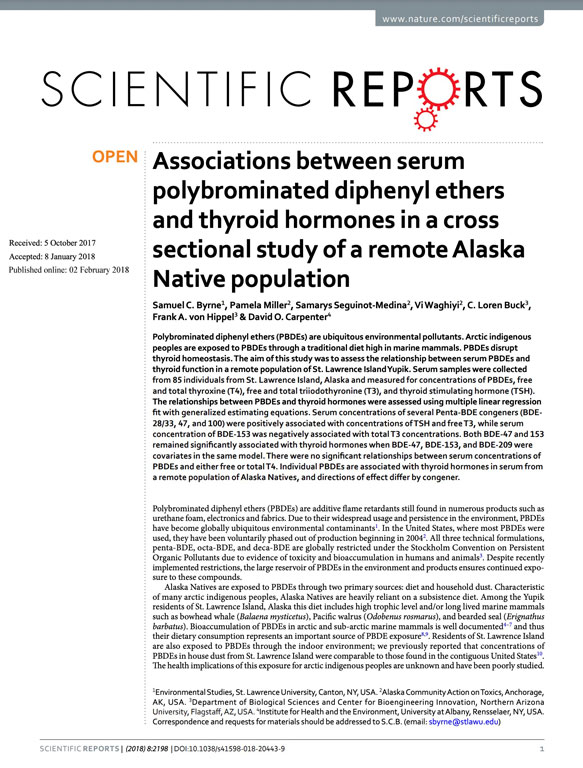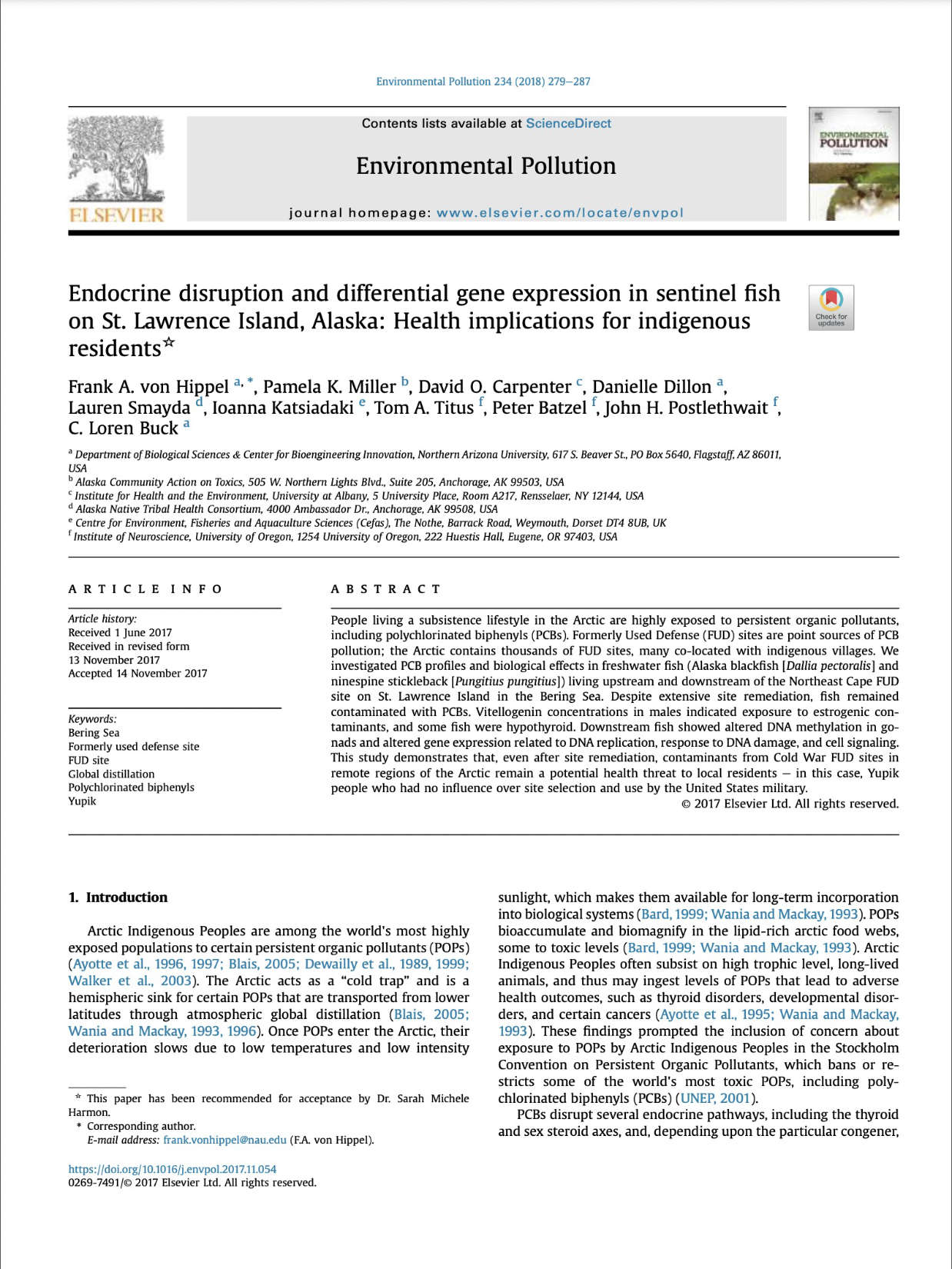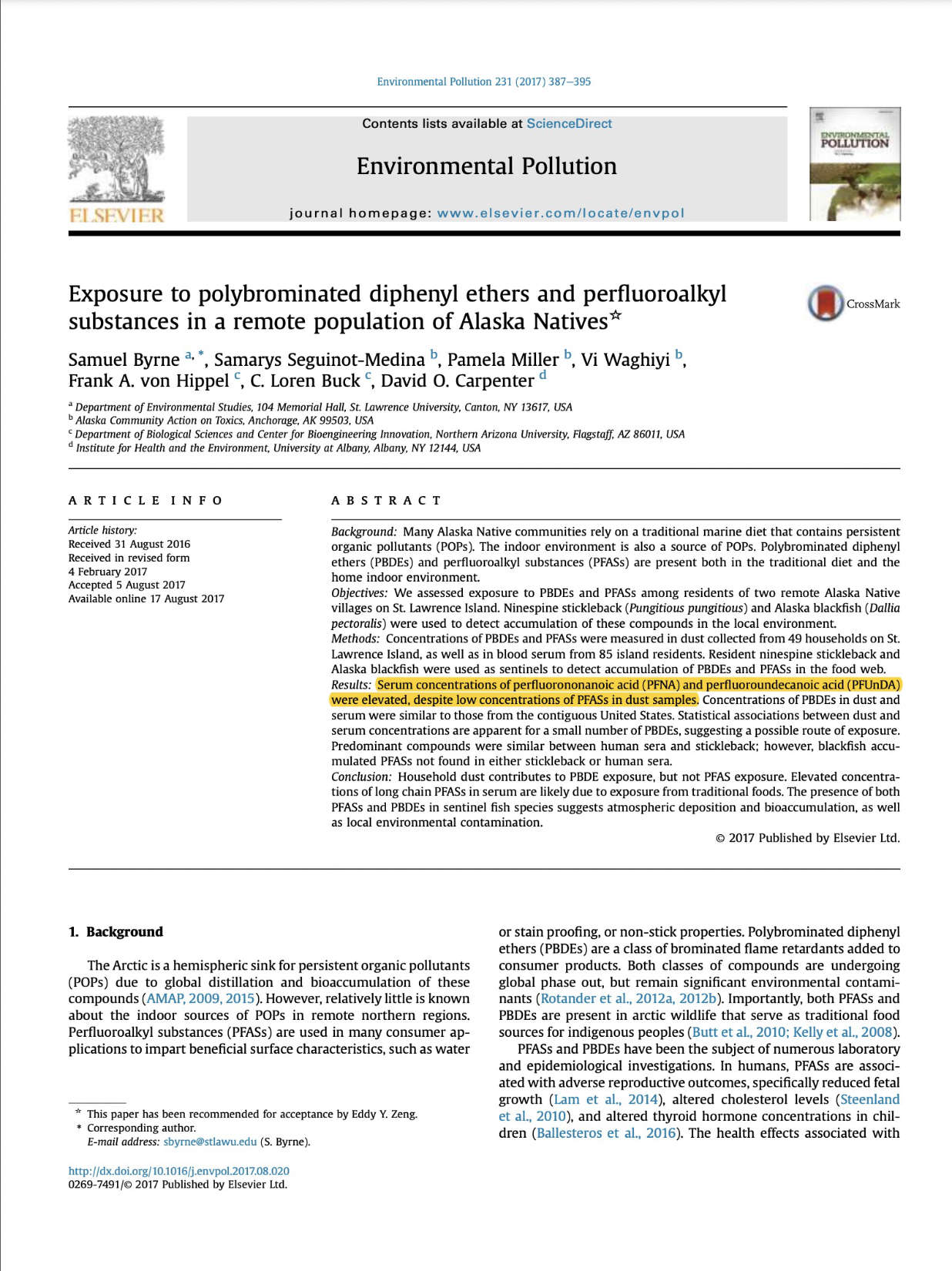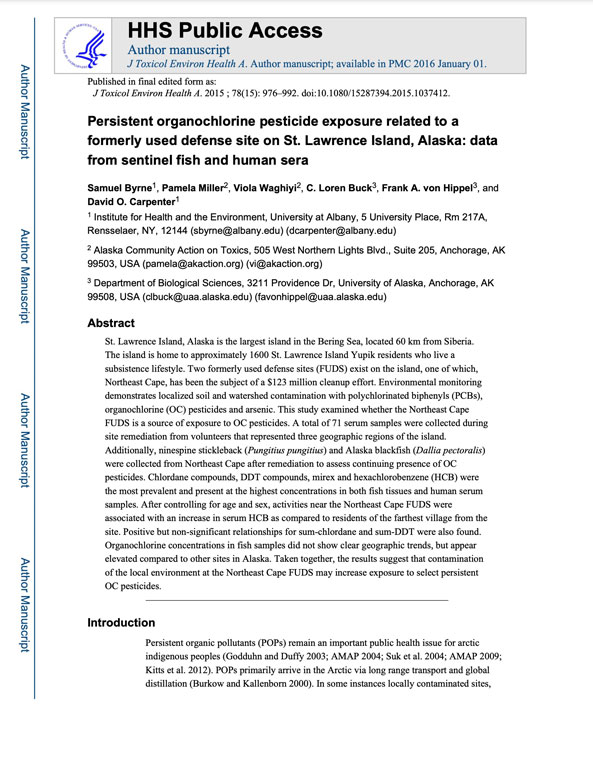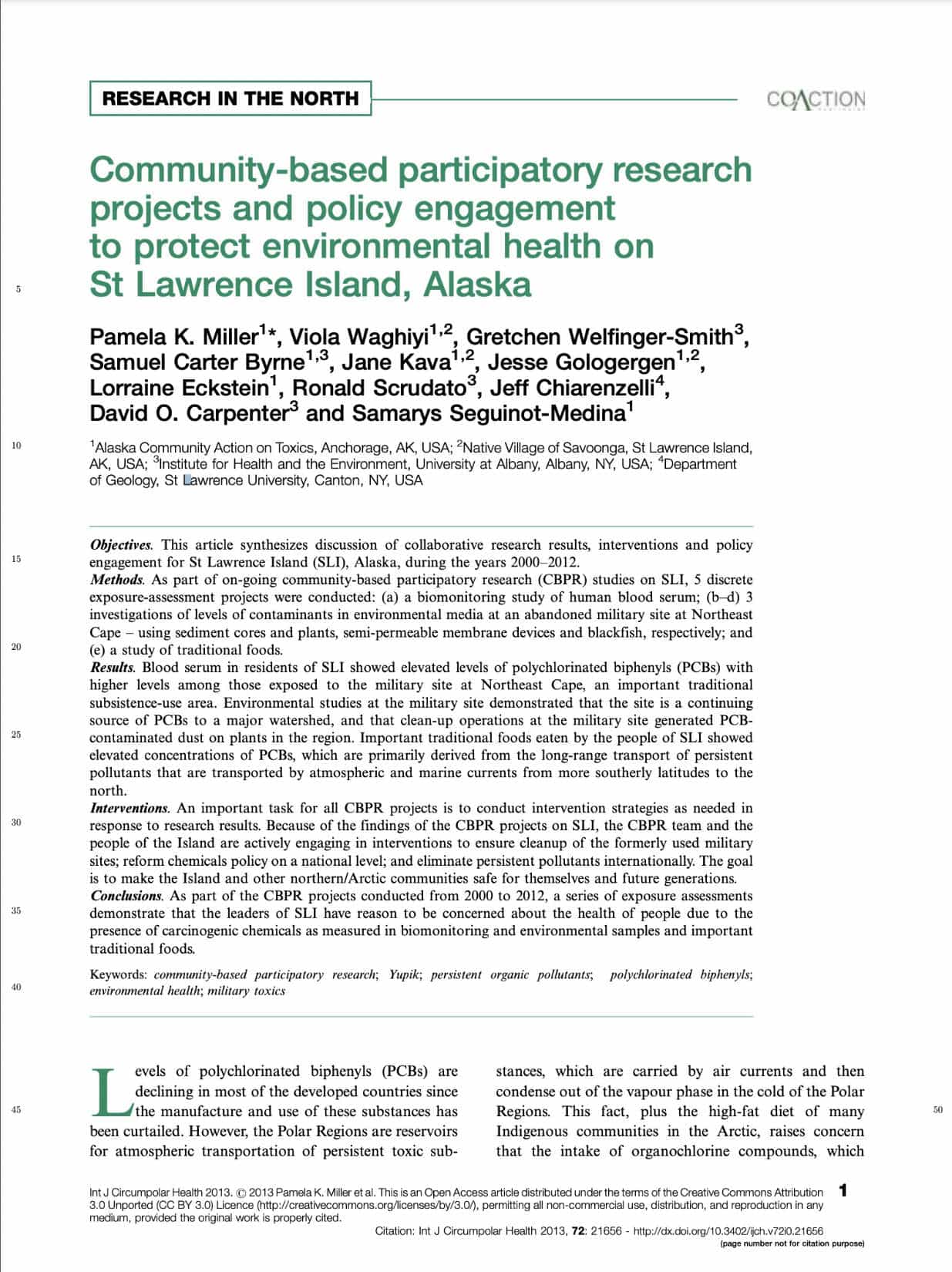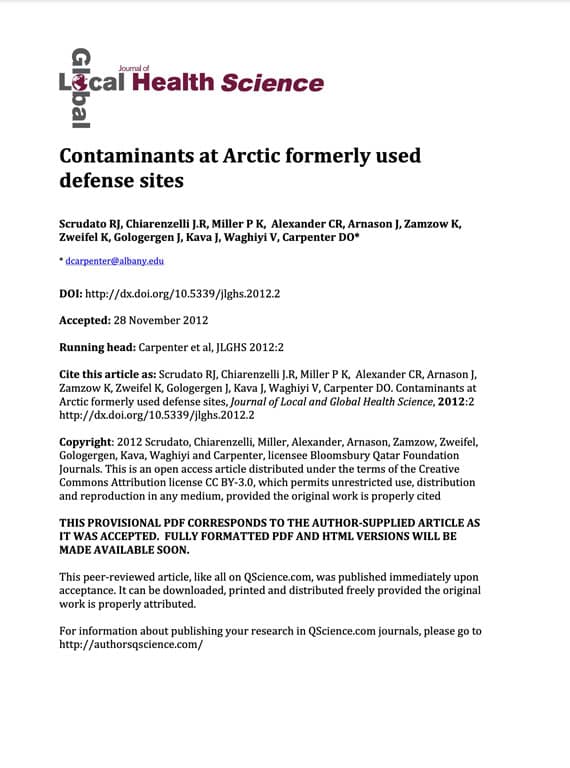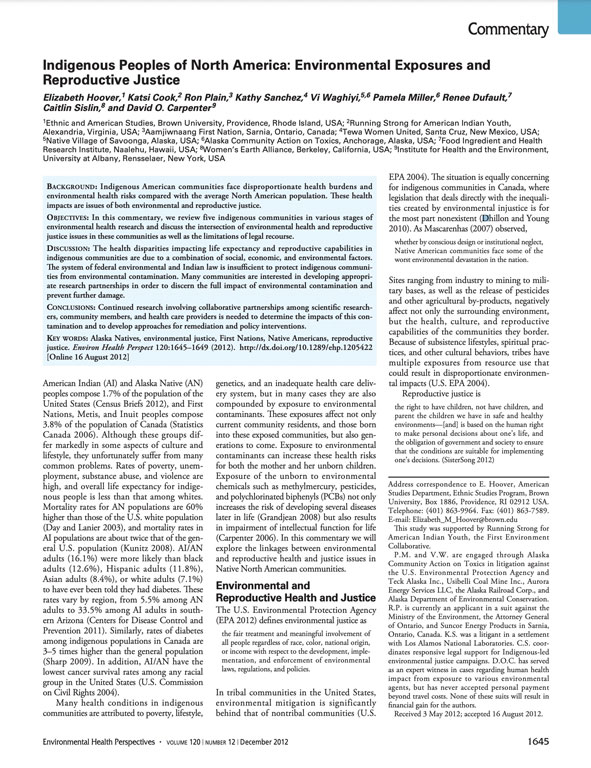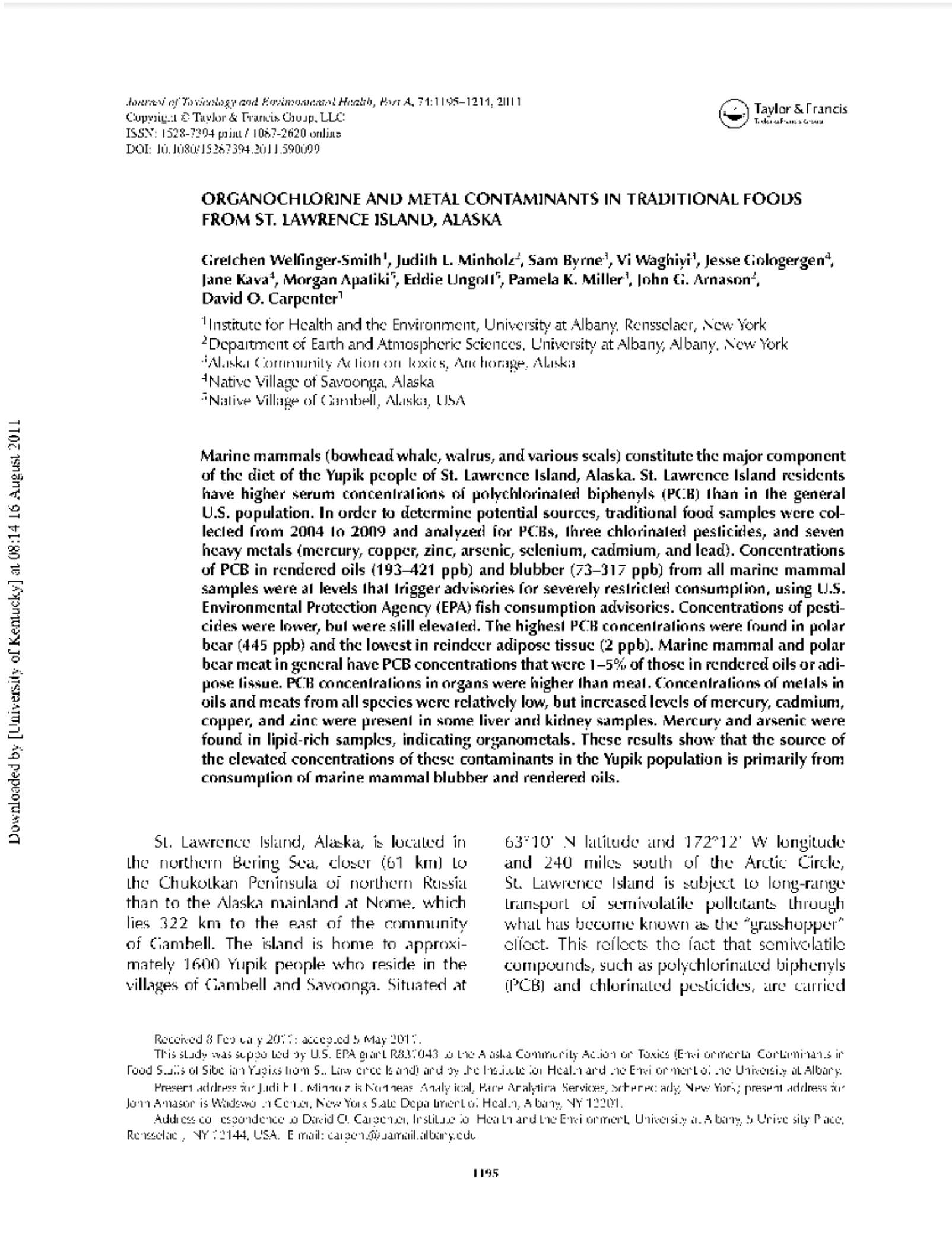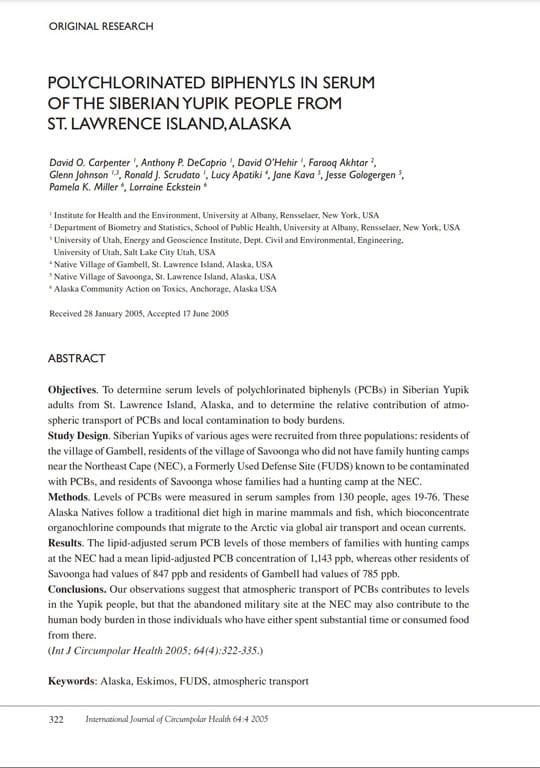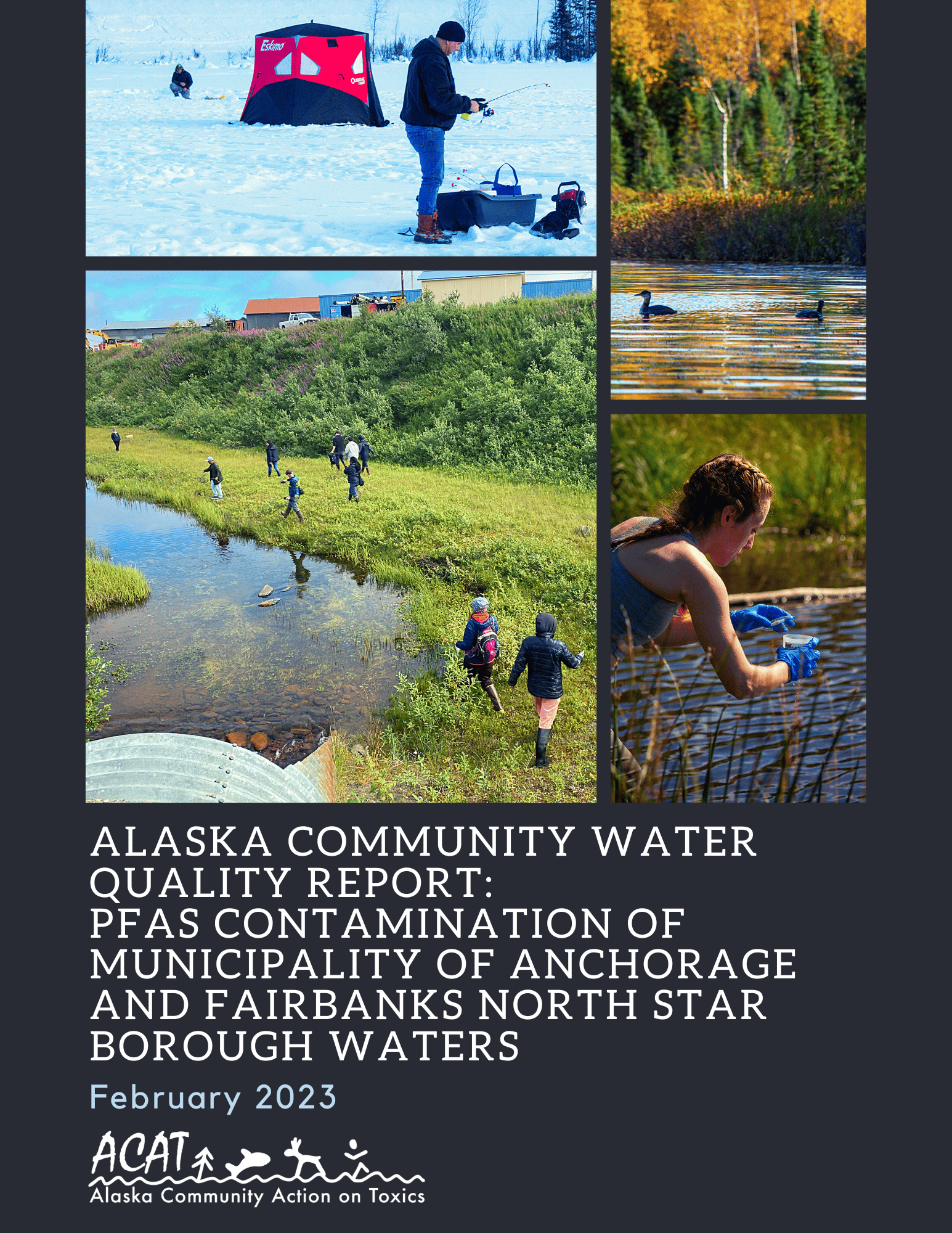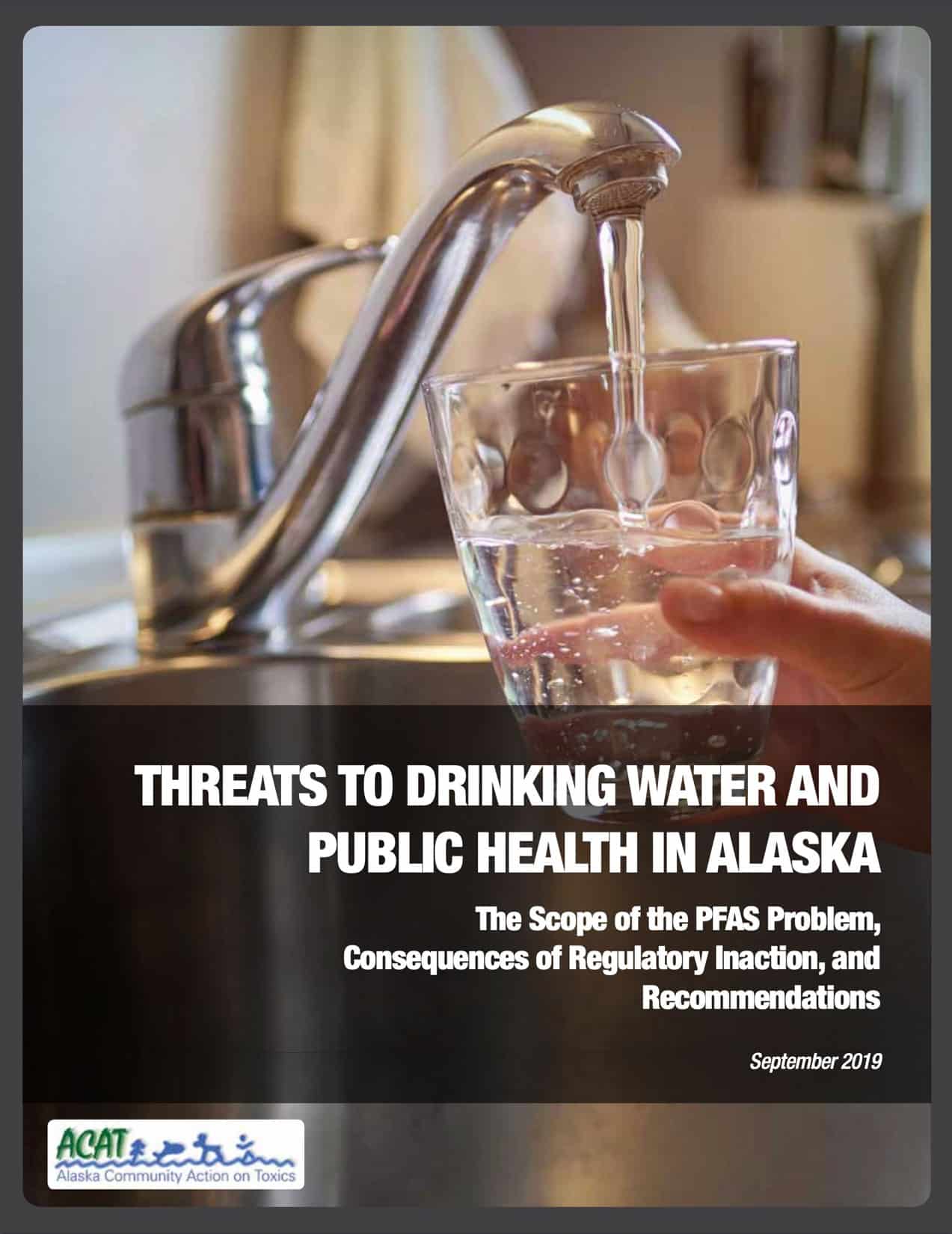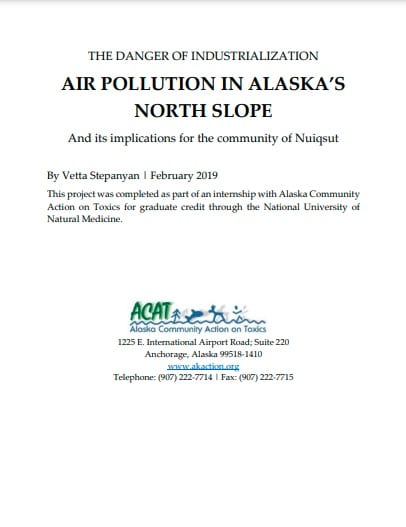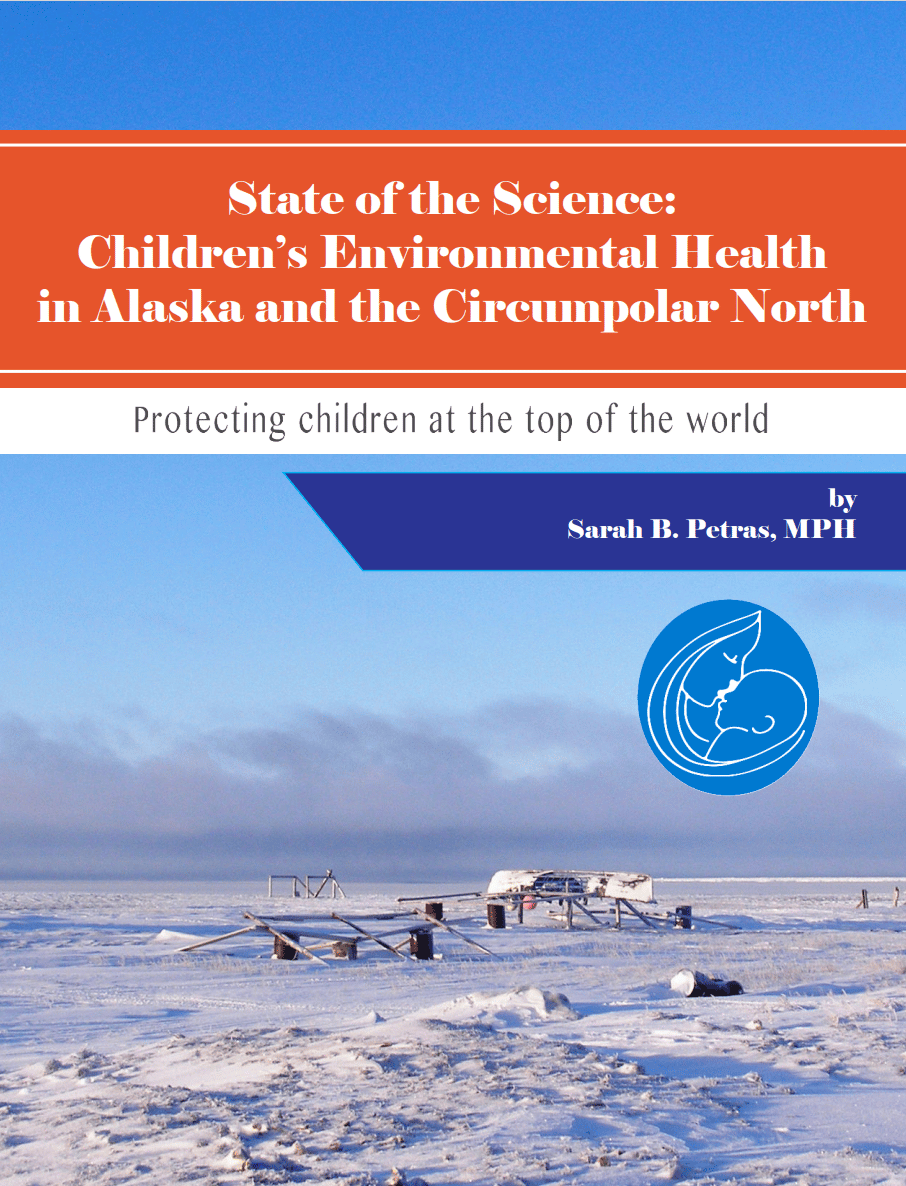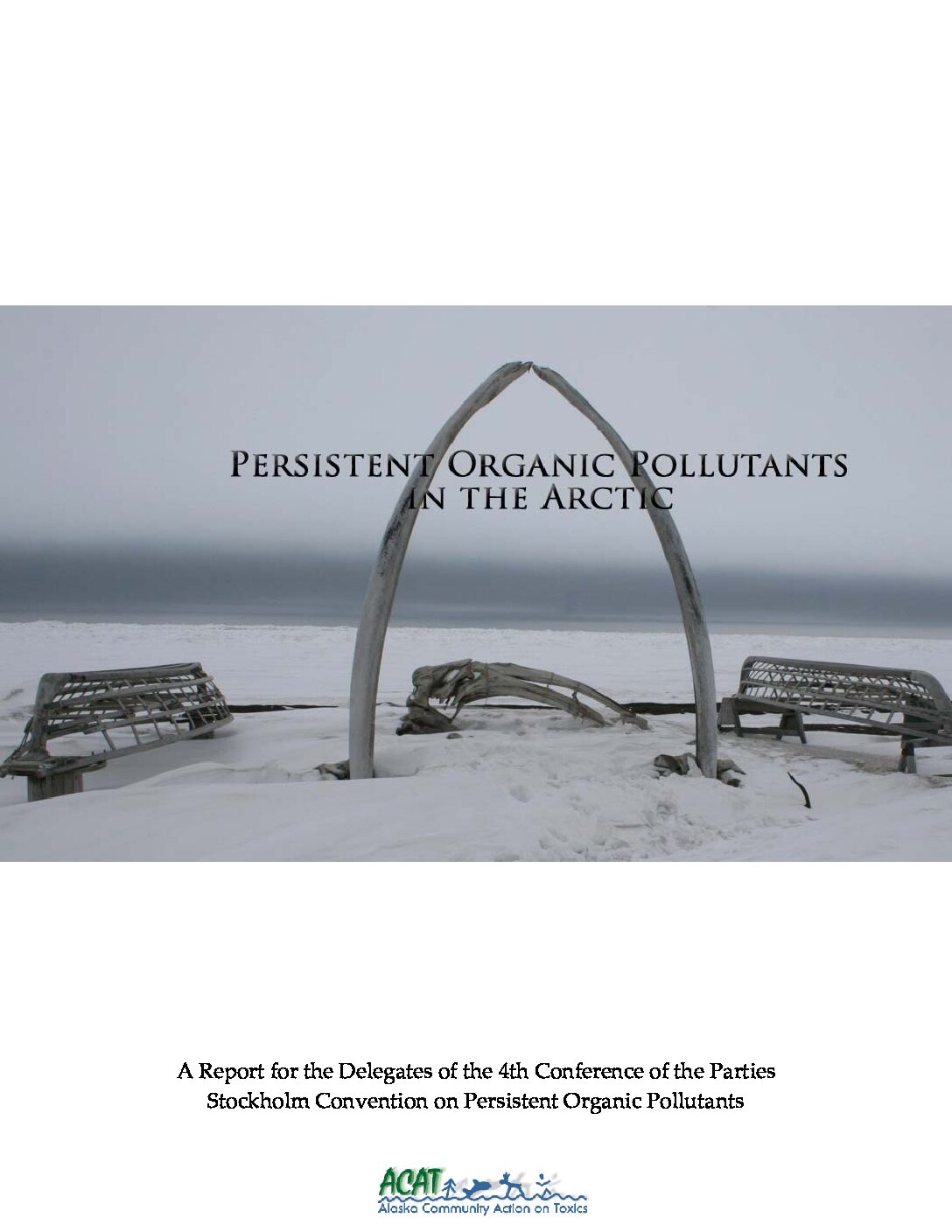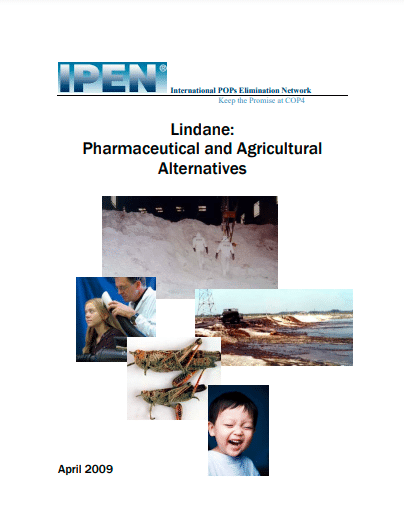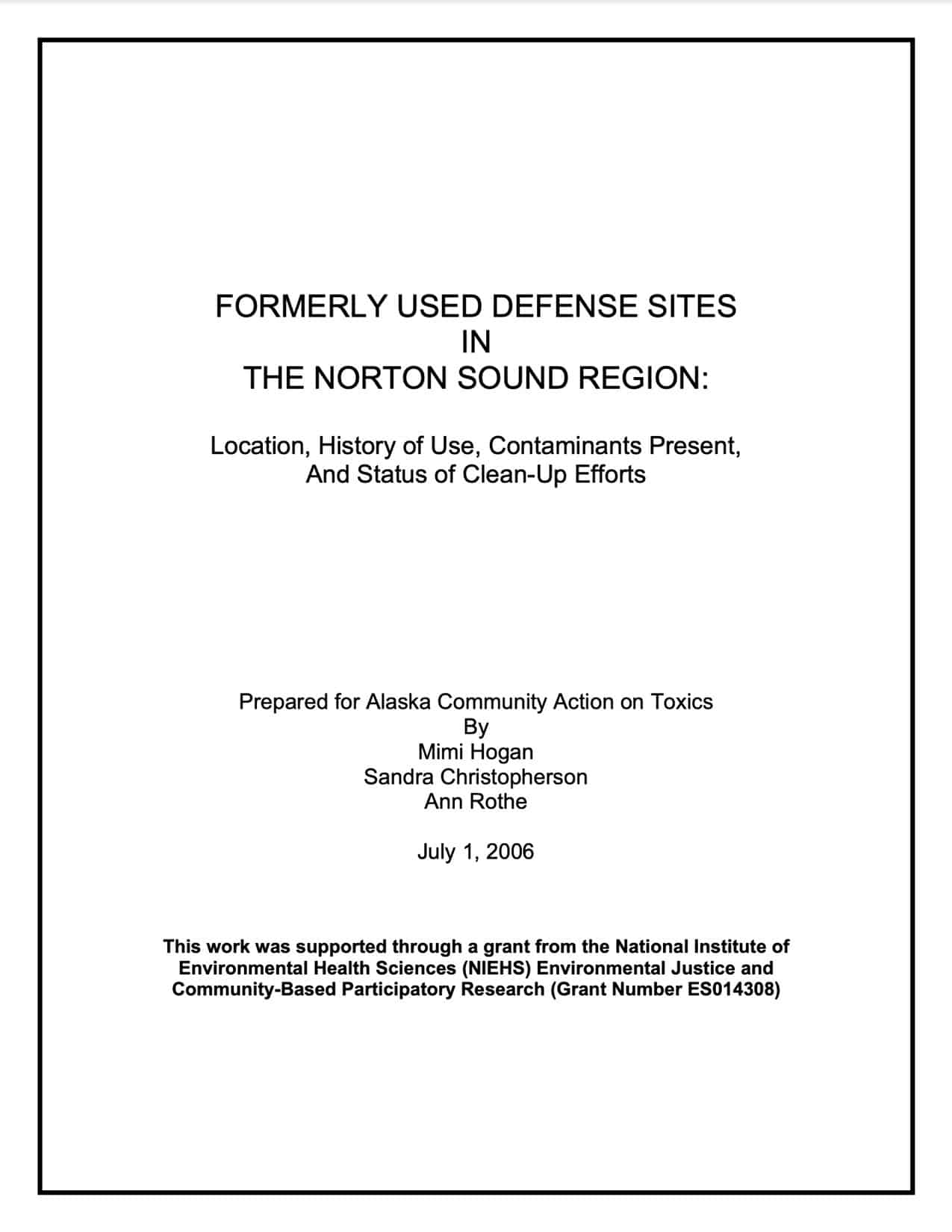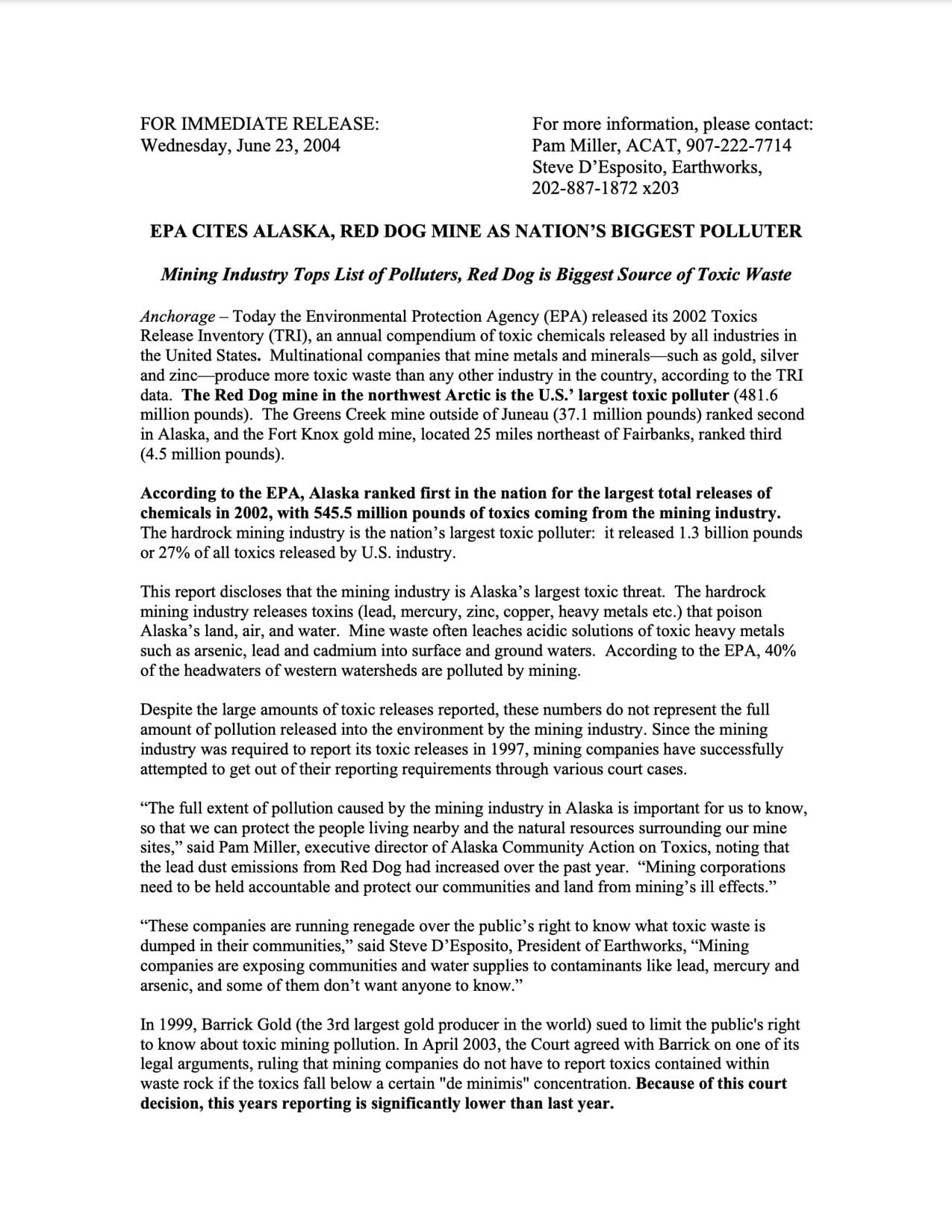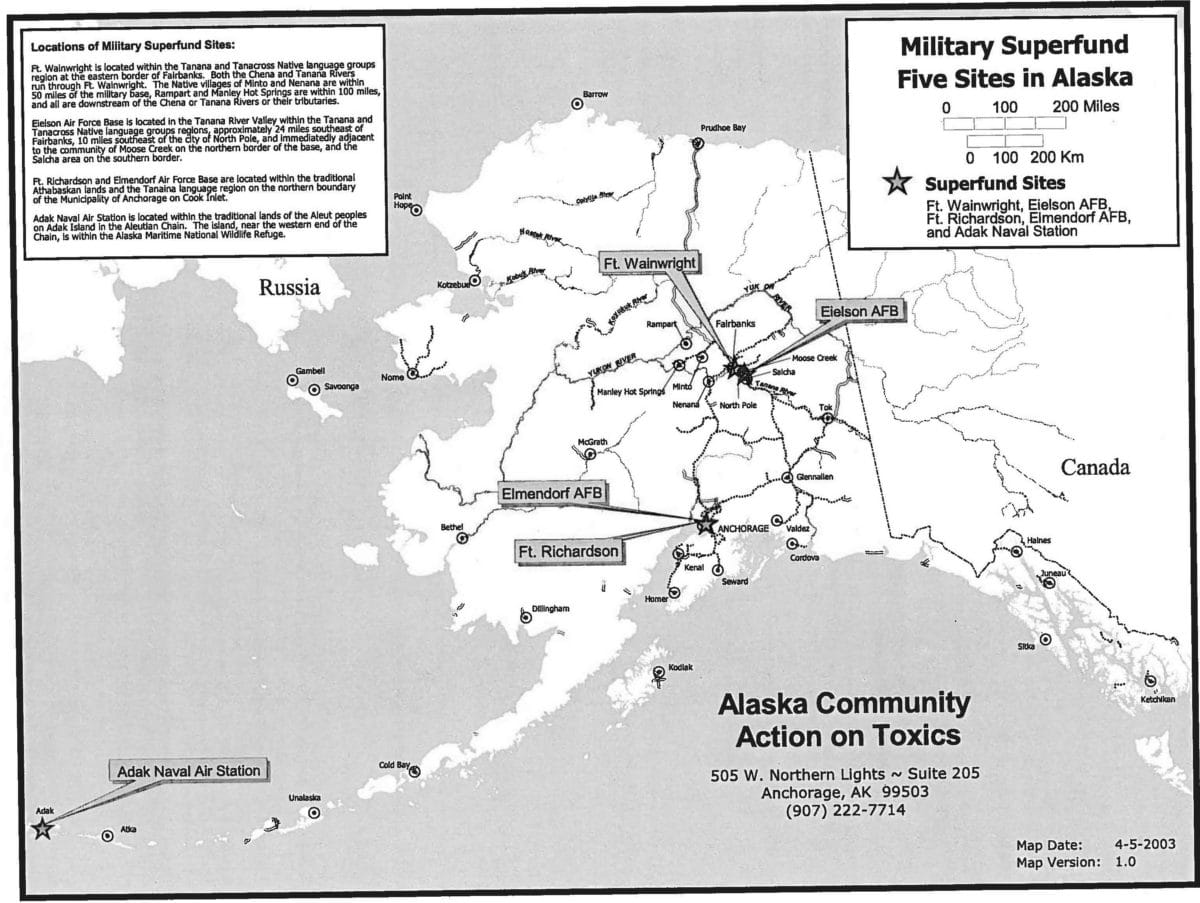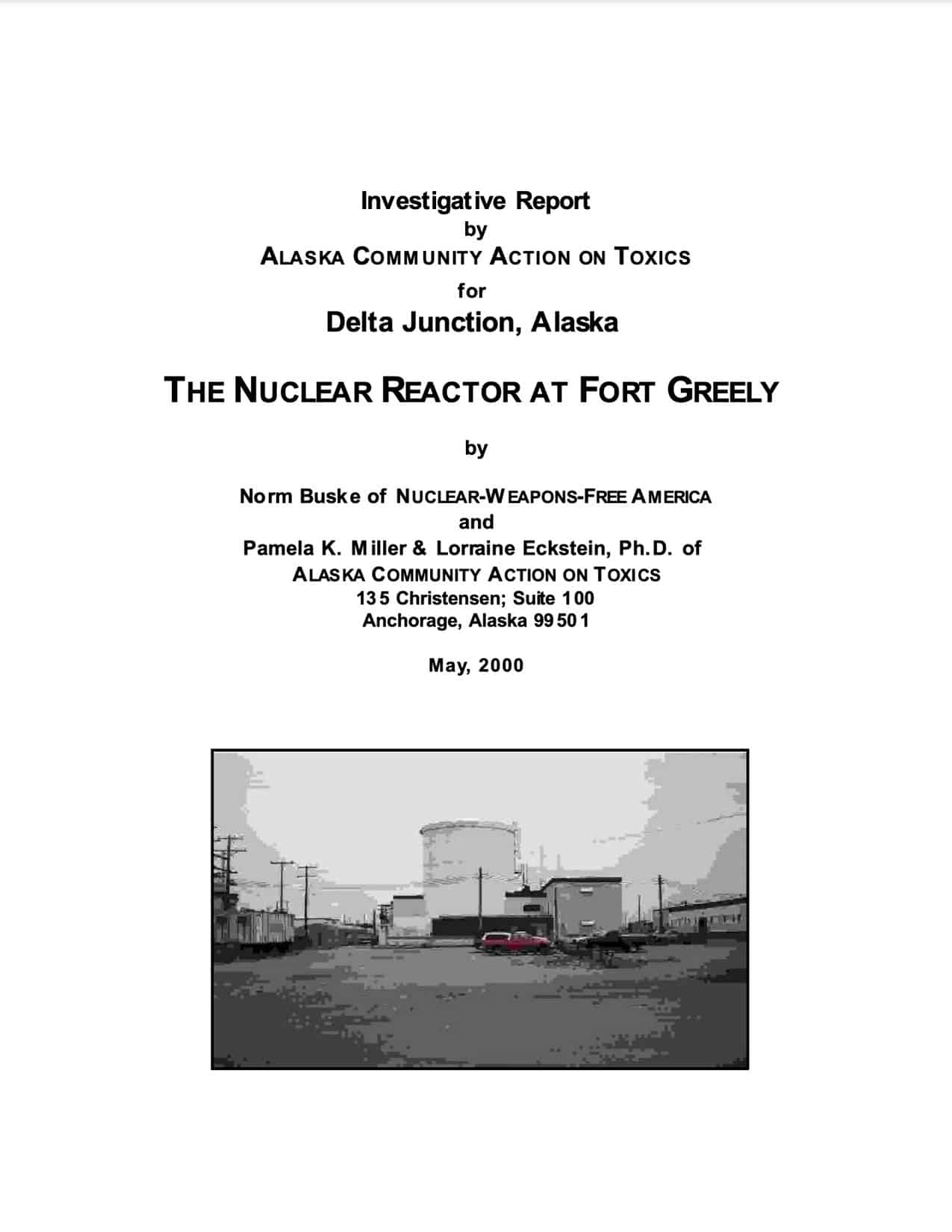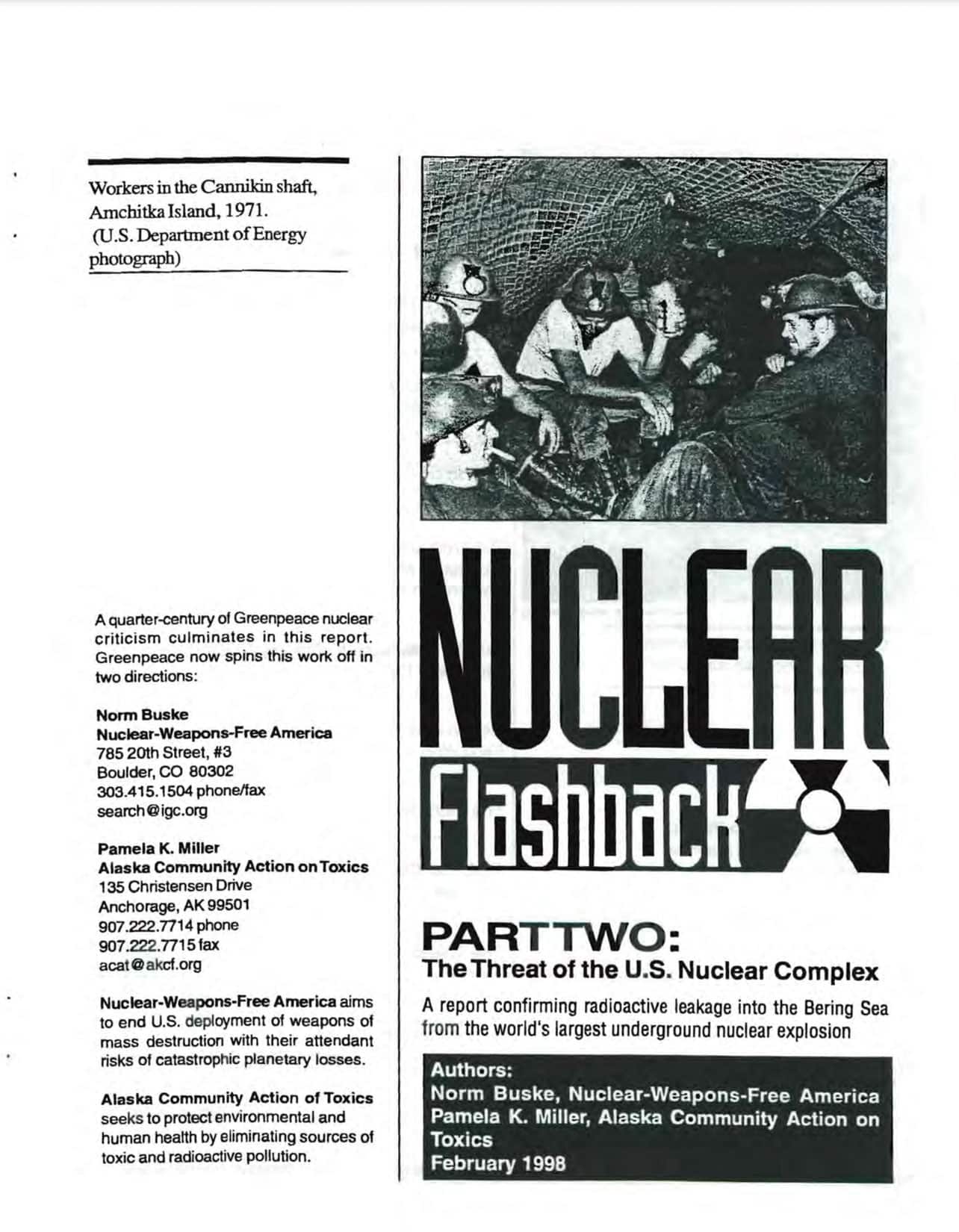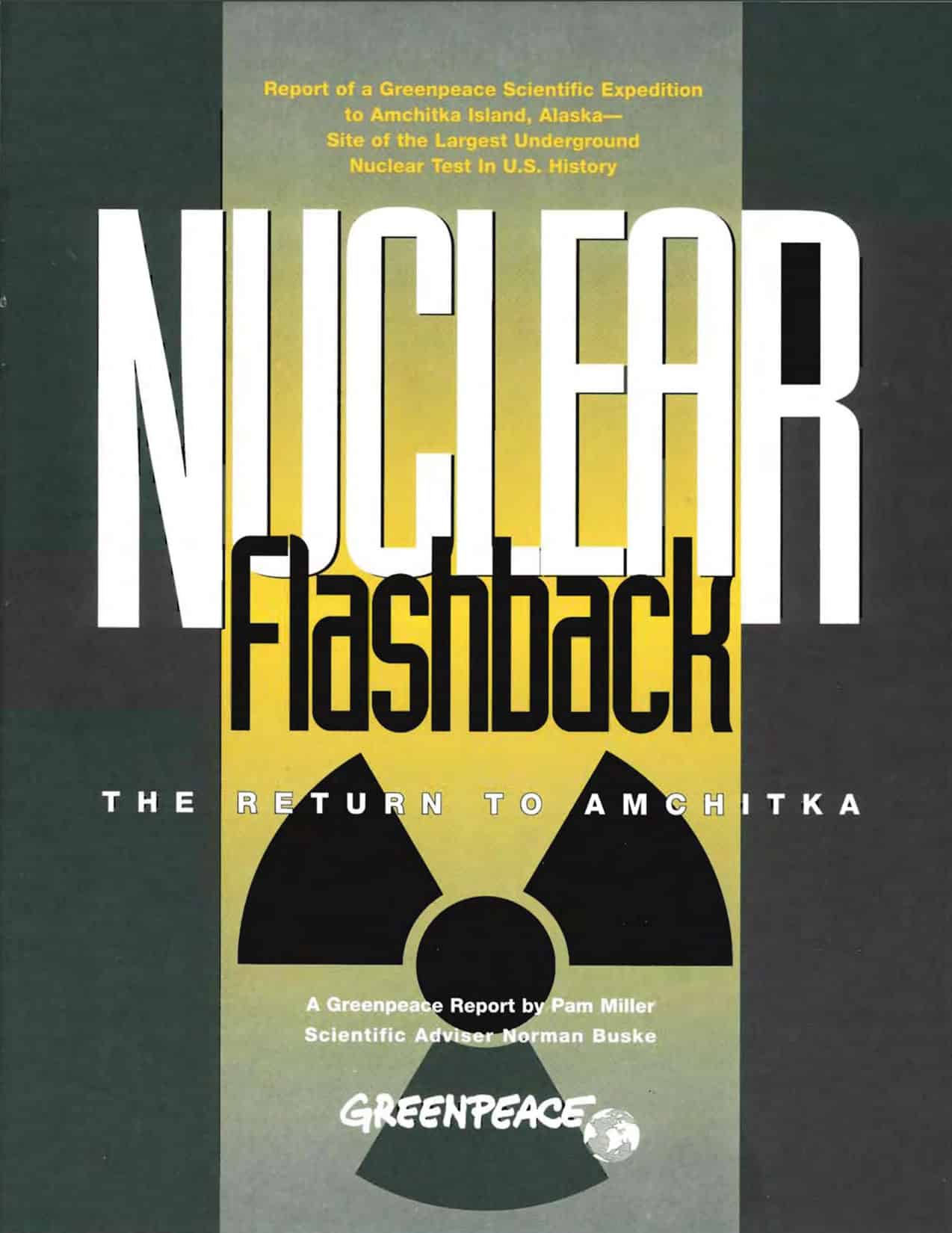Publications
Publications in Peer-Reviewed Journals
- All
- Biomonitoring
- Children’s Health
- Climate & Chemicals
- Community Based Participatory Research
- Environmental Health & Justice
- Food Security
- Military Toxics
- Persistent Organic Pollutants (POPs)
- Pesticides & Alternatives
- PFAS
- Publications
- Reproductive Health
- Water Quality
The Arctic’s Plastic Crisis: Toxic Threats to Health, Human Rights, and Indigenous Lands From the Petrochemical Industry
Damage to the Arctic from the fossil fuel/petrochemical industry includes threats from chemicals, plastics, and climate. These have combined to poison the lands, waters, and traditional foods of Arctic Indigenous Peoples, with ongoing health effects that threaten their cultures and communities. This report highlights the voices and testimonies of Indigenous leaders who have witnessed these…
Differential gene expression and developmental pathologies associated with persistent organic pollutants in sentinel fish in Troutman Lake, Sivuqaq, Alaska
Persistent organic pollutants (POPs) are lipophilic compounds that bioaccumulate in animals and biomagnify within food webs. Many POPs are endocrine disrupting compounds that impact vertebrate development. POPs accumulate in the Arctic via global distillation and thereby impact high trophic level vertebrates as well as people who live a subsistence lifestyle. The Arctic also contains thousands of point…
Diffusive fluxes of persistent organic pollutants between Arctic atmosphere, surface waters and sediments
Arctic communities are disproportionately exposed to pollutants from sources including global atmospheric transport and formerly used defense sites (FUDS). The effects of climate change and increasing development in the Arctic have the potential to exacerbate this problem. Yupik People of Sivuqaq, or St Lawrence Island, Alaska are one such community with documented exposures to pollutants from FUDS, and their…
Protecting the health of future generations in the arctic through community-based participatory research and action
The Arctic is a hemispheric sink for persistent industrial chemicals and pesticides that are transported on atmospheric and oceanic currents from lower latitudes through a process known as global distillation. These chemicals bioaccumulate in the bodies of fish, wildlife, and people of the north. Far from pristine, the Arctic contains some of the most highly…
PFAS and PBDEs in traditional subsistence foods from Sivuqaq, Alaska
The Arctic is a hemispheric sink for both legacy and current use persistent organic pollutants (POPs). Once in the Arctic, POPs biomagnify in food webs, potentially reaching concentrations in high trophic level animals that pose a health concern for people who subsist on those animals. Indigenous Peoples of the Arctic may be highly exposed to…
PFAS in drinking water and serum of the people of a southeast Alaska community: A pilot study
This study assessed PFAS exposure in Gustavus, a small southeast Alaska community, located near a significant PFAS source from airport operations and fire training sites. Our results confirm the presence of a significant PFAS source and suggest that contaminated drinking water from private wells contributes to the overall PFAS body burden in Gustavus residents.
Elevated mercury and PCB concentrations in Dolly Varden (Salvelinus malma) collected near a formerly used defense site on Sivuqaq, Alaska
Sivuqaq’s proximity to Russia made it a strategic location for U.S. military defense sites during the Cold War. Our results suggest that the Northeast Cape FUD site remains a significant point source of mercury and PCB pollution and contributes to higher concentrations in resident fish, including subsistence species. Moreover, elevated Hg and PCB levels in…
Legacy and emerging semi-volatile organic compounds in sentinel fish from an arctic formerly used defense site in Alaska
The purpose of this study was to investigate the extent of contamination from military operations on Alaska’s St. Lawrence Island (Sivuqaq) through the analysis of sentinel fish, the ninespine stickleback (Pungitius pungitius), collected from Troutman Lake located within the watershed of a formerly used defense site and adjacent to the Yupik community of Gambell. The…
Exposure to perfluoroalkyl substances and associations with serum thyroid hormones in a remote population of Alaska Natives
Perfluoroalkyl substances (PFASs) are known to accumulate in traditional food animals of the Arctic, and arctic indigenous peoples may be exposed via consumption of subsistence-harvested animals. PFASs are suspected of disrupting thyroid hormone homeostasis in humans. The aim of this study is to assess the relationship between serum PFASs and thyroid function in a remote…
Associations between serum polybrominated diphenyl ethers and thyroid hormones in a cross sectional study of a remote Alaska Native population
The aim of this study was to assess the relationship between serum PBDEs and thyroid function in a remote population of St. Lawrence Island Yupik people. Serum samples were collected from 85 individuals from St. Lawrence Island, Alaska and analyzed for concentrations of PBDEs, free and total thyroxine (T4), free and total triiodothyronine (T3), and…
Endocrine disruption and differential gene expression in sentinel fish on St. Lawrence Island, Alaska: Health implications for indigenous residents
We investigated polychlorinated biphenyls (PCBs) profiles and endocrine disruption in Alaska blackfish and ninespine stickleback living in the vicinity of the Northeast Cape formerly used defense (FUD) site on St. Lawrence Island in the Bering Sea. FUD sites are point sources of PCB pollution; the Arctic contains thousands of FUD sites, many co-located with indigenous…
Exposure to polybrominated diphenyl ethers and perfluoroalkyl substances in a remote population of Alaska Natives
We assessed exposure to PBDEs and PFAS among residents of two remote Alaska Native villages on St. Lawrence Island. We also measured these contaminants in the sentinel fish species, ninespine stickleback and Alaska blackfish.
Persistent organochlorine pesticide exposure related to a formerly used defense site on St. Lawrence Island, Alaska: data from sentinel fish and human sera
This study examined whether the Northeast Cape FUDS is a source of exposure to organochlorine pesticides. A total of 71 serum samples were collected during site remediation from volunteers that represented three geographic regions of Sivuqaq (St. Lawrence Island). We found elevated levels of pesticides associated with the former military site in the environment and…
Community-based participatory research projects and policy engagement to protect environmental health on St Lawrence Island, Alaska
This article synthesizes our collaborative community-based research results, interventions and policy engagement for St Lawrence Island, Alaska, during the years 2000-2012.The research team conducted exposure assessment studies that investigated sources from military contamination as well as long range transport.
Contaminants at Arctic formerly used defense sites
This study found elevated levels of contaminants from the military site at Northeast Cape in sediments and plants, including mercury, mirex and other pesticides, and PCBs. Through congener-specific analysis, we were able to distinguish contaminants from the military sites in the region from those accumulated through long-range transport.
Indigenous Peoples of North America: Environmental Exposures and Reproductive Justice
Our paper found that health disparities impacting life expectancy and reproductive capabilities in indigenous communities are due to a combination of social, economic, and environmental factors. The system of federal environmental and Indian law is insufficient to protect indigenous communities from environmental contamination. The paper discusses reproductive health disparities in Indigenous communities, including Sivuqaq.
Organochlorine and Metal Contaminants in Traditional Foods from St. Lawrence Island, Alaska
St. Lawrence Island residents have higher serum concentrations of polychlorinated biphenyls (PCB) than in the general U.S. population. In order to determine potential sources, traditional food samples were collected from 2004 to 2009 and analyzed for PCBs, three chlorinated pesticides, and seven heavy metals (mercury, copper, zinc, arsenic, selenium, cadmium, and lead).
Polychlorinated Biphenyls In Serum Of The Siberian Yupik People From St. Lawrence Island, Alaska
The aim of this study was to determine serum levels of polychlorinated biphenyls (PCBs) in Yupik adults from St. Lawrence Island, Alaska, and to determine the relative contribution of atmospheric transport of PCBs and local contamination to body burdens. Our study found that atmospheric transport of PCBs contributes to elevated levels in the Yupik people,…
Investigative Reports
- All
- Air Quality
- Biomonitoring
- Children’s Health
- Community Based Participatory Research
- Environmental Health & Justice
- Food Security
- Military Toxics
- Mining
- Persistent Organic Pollutants (POPs)
- Pesticides & Alternatives
- PFAS
- Publications
- Water Quality
Alaska Community Water Quality Report: PFAS Contamination of Municipality of Anchorage and Fairbanks North Star Borough Waters
Alaska Community Action on Toxics (ACAT) conducted independent water quality testing in 2022 that showed PFAS (per- and polyfluoroalkyl substances) contamination in Anchorage lakes as well as in Ship Creek. These results show contamination in lakes used for swimming and fishing. The results also show contamination in Ship Creek downstream from Joint Base Elmendorf and…
Threats to Drinking Water and Public Health in Alaska – The Scope of the PFAS Problem, Consequences of Regulatory Inaction, and Recommendations
This investigative report informs actions to address the public health crisis caused by PFAS contamination. In Alaska, the dispersive use of AFFF (aqueous film forming foam) on military bases and airports has contaminated the drinking water of communities from the North Slope to SE Alaska. PFAS have been discovered at over 100 individual sites (mostly…
Air pollution in Alaska’s North Slope and its implications for the community of Nuiqsut
Alaska’s North Slope is the region north of the crest of the Brooks Range and is one of the most extreme environments in which humans live. There are eight communities in Alaska’s North Slope: Anaktuvuk Pass, Atqasuk, Barrow, Kaktovik, Nuiqsut, Point Hope, Point Lay, and Wainwright. The community of Nuiqsut is located 136 miles southeast…
Formerly Used Defense Sites in the Norton Sound Region
This report summarizes information about formerly used defense sites in the Norton Sound region, including locations, history, contaminants, and status of clean up. The report also includes a map of the military sites in the region.
Red Dog and Subsistence: Analysis of Reports on Elevated Levels of Heavy Metals in Plants Used for Subsistence Near Red Dog Mine, Alaska
The study team collected vegetation samples from a site at the port and from traditional subsistence harvest areas for the villages of Point Hope, Kivalina and Noatak, all three within an 80-mile radius of the mine. This study found that cadmium concentrations were highest in vegetation samples collected at the port and that lead concentrations…
The Nuclear Reactor at Fort Greely
This report offers evidence that the U.S. Army is disguising the true mission of the nuclear reactor at Fort Greely, Alaska. Rather than a plant to provide heating and electricity to the base, the Fort Greely reactor was covertly designed and operated as a small pilot plant to produce special nuclear materials suitable for use…
Nuclear Flashback Part II: The Threat of the U.S. Nuclear Complex
This report confirms radioactive leakage into the Bering Sea from the world’s largest underground nuclear explosion. Government data show americium-241 leaking from all three nuclear blast sites under Amchitka Island, Alaska. Americium-241 is a radionuclide with a 433-year half-life. It is produced by the decay of plutonium that fueled the bombs. The full extent of…
Nuclear Flashback: The Return to Amchitka
Amchitka Island, Alaska was the site of three underground nuclear tests: Long Shot, an 80 kiloton test (80,000 tons TNT equivalent) in 1965; Milrow, a 1 megaton test (1,000,000 tons TNT equivalent) in 1969; and Cannikin, a 5 megaton test (5,000,000 tons TNT equivalent) in 1971. Project Cannikin was the largest underground nuclear test in…

